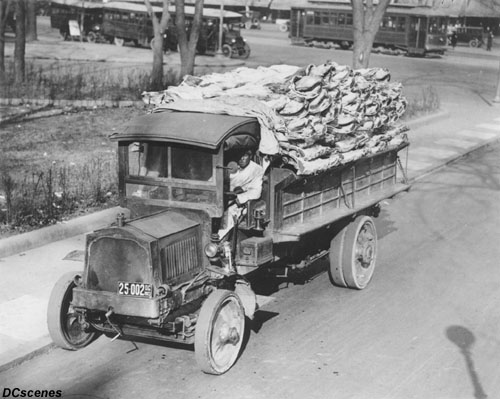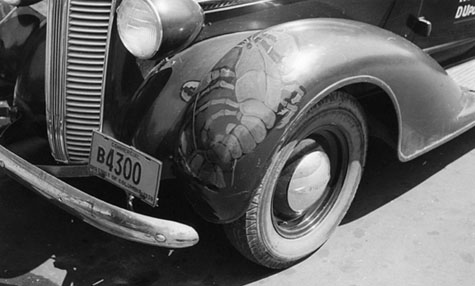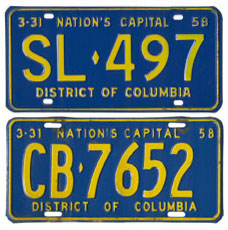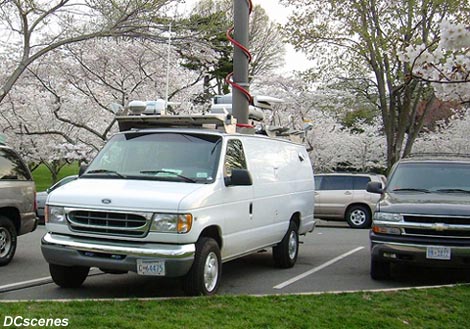Washington, D.C. Commercial (Truck) License Plates
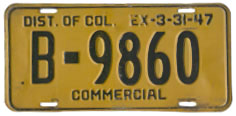
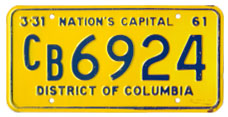
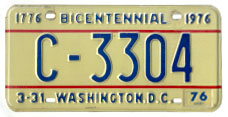
As with less common D.C. types, what we know about early commercial plates is based almost exclusively on observation of existing examples and period photographs rather than historical records of what was actually issued. The letter C is most often associated with this type, but A, B, and D have also been used, sometimes alone and at other times following a C. Here's a summary of the type history that's detailed below:
-
Specially-marked 1926 truck plates in a photo taken that year and 1925 photos that show trucks registered with all-number (i.e. passenger car) plates are our basis for concluding that 1926 was the first year for this plate type.
-
It is assumed that both letter prefixes known to have been used on truck plates for 1927 (B and C) were also used in 1926 and 1928 through 1934.
-
Plates of 1935 through early 1948 include COMMERCIAL, and a letter prefix appears on most plates of this period.
-
Between April 1948 and March 1969 the letter C, most often in a prefix position, marks commercial plates. In most years a second letter (usually A, B, or another C) follows the C prefix.
-
Since April 1969 all commercial plates have been marked simply with a C prefix followed by up to five numbers.
Before 1926. It seems unlikely that distinctive plates were issued for use on commercial vehicles prior to 1926 in light of 1925 and earlier photos showng trucks registered with what today we consider passenger car plates, i.e. those with an all-numeric combination. (Click here to see these wonderful early D.C. trucking images.) That special truck plates were not introduced in D.C. until so relatively late is unusual because all but four of the 48 states had issued them by the end of 1925, although it is worth noting that they were introduced last in Maryland, in 1947, which was even after the Alaska and Hawaii territories first issued them. As was the case in Maryland it's possible that in D.C. there was a separate commercial registration classification (with a registration fee different from that charged for private passenger cars) by the early 1920s even though specially-marked plates were not provided. However, based on clear period photographs we believe it's reasonable to conclude that 1926 was the first year for this type.
1926-1934. Effective with the 1927 registration year there were two series of D.C. plates for commercial vehicles: a letter B prefix marked plates issued for use on vehicles with a manufacturer's rated capacity of 2,500 lbs. or less, and C-prefix plates were issued for trucks with a capacity greater than 2,500 lbs. Only C-prefix pates have been observed for 1926. By December 1932 the manner of classifying commercial vehicles had been changed. B-prefix plates were then used on vehicles with an empty weight of up to 3,000 lbs., and C-prefix plates were displayed on heavier commercial vehicles as well as tractors. It is reasonable to assume that these two letter prefixes were used through 1934, although no evidence to support this assumption has been found. The first period during which numbers on most D.C. non-passenger plates began with a letter to indicate the registration type came to an end with the close of 1934.
1935-1947. This is a confusing era for all D.C. non-passenger plates, and commercial is a particularly difficult type to understand due to the resumption of letter prefixes in 1938. No prefix letters appeared on plates of most (if not all) other types during this period.
From 1935 through the 1946 (3-31-47) baseplate (which was revalidated for 1947 with a "48" tab to expire 3-31-48), private passenger plates were numbered from 1 through 9999, and then numbers that began at some five-digit number substantially higher than 10-000. The lowest five-digit numbers, beginning at various points at or above 10-000 for various types, were used for non-passenger plates of most types throughout this period but on commercial plates apparently only for 1935, 1936, and 1937. Listed here are numbering formats and plate characteristics reported (but in some cases not verified) about 1935-47 commercial plates as well as numbers and information about examples actually observed.
Base |
|
COMMERCIAL |
12-345 format |
top |
|
1936 |
12-345 format |
bottom |
1937 |
25-082, 42-101 |
bottom |
1938 |
B1754, B4300 |
top |
1939 ("2-29-40") |
C5080 |
bottom |
1940 ("3-31-41") |
A 11, B 476 |
bottom |
1941 ("3-31-42") |
A 8 |
top |
C prefix reported |
||
1942-44 ("3-31-43") |
C-5109 |
bottom |
1945 ("3-31-46") |
B-796, D-1599 |
top |
1946-47 ("3-31-47") |
B-83, B-9860, |
bottom |
D-1870 |
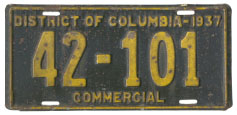 Upon reviewing this data, a question arises about the significance of the letter prefixes. Before we consider that, however, let's look at the all-number plates issued for 1935, 1936, and 1937. If we assume that for 1934 registration purposes all commercial vehicles were still classified in one of two categories, as we know they were in 1927, and if we assume that there were different registration fees for each class, then it makes sense to assume that those classifications were not discarded for 1935. Therefore, it seems reasonable (but by no means certain) to speculate that two separate blocks of all-number registrations may have been set aside for the two classes of commercial registrations. Hopefully we can collect more registration number data for truck plates of this era. The lowest observed passenger plate from this three-year period is from the 47-000 series. Perhaps truck plates of the two weight classes were numbered in the 20-000 and low 40-000 series.
Upon reviewing this data, a question arises about the significance of the letter prefixes. Before we consider that, however, let's look at the all-number plates issued for 1935, 1936, and 1937. If we assume that for 1934 registration purposes all commercial vehicles were still classified in one of two categories, as we know they were in 1927, and if we assume that there were different registration fees for each class, then it makes sense to assume that those classifications were not discarded for 1935. Therefore, it seems reasonable (but by no means certain) to speculate that two separate blocks of all-number registrations may have been set aside for the two classes of commercial registrations. Hopefully we can collect more registration number data for truck plates of this era. The lowest observed passenger plate from this three-year period is from the 47-000 series. Perhaps truck plates of the two weight classes were numbered in the 20-000 and low 40-000 series.
As for the 1938-47 letter prefixes, if certain number blocks were indeed assigned to the two different commercial vehicle classes from 1935-37, it's a reasonable assumption that the distinction was too difficult for police officers and others to make, and that the pre-1935 letter prefixes were therefore restored in a period during which they were not used on other plate types. It seems likely that the previous letters for the two weight classes, B and C, were brought back into use. As for the appearance of A and D prefixes, they may be overflow series. After plate no. B-9999 was assigned, numbers A-1, A-2, etc. were probably issued for light trucks. Similarly, upon issuance of heavy truck plate no. C-9999 numbers were probably assigned sequentially beginning at D-1.
 |
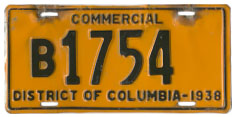 |
1937 |
1938 |
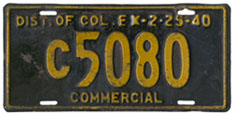 |
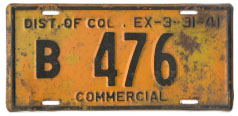 |
1939 |
1940 |
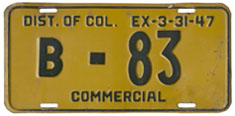 |
 |
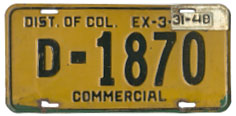 |
1946 |
1946 |
1946 base validated for 1947 |
Plates of this era that include both COMMERCIAL and a B prefix to the number have, in some past writings on the subject, been classified as bus plates. Bus is a type that's as confusing as commercial, and there is no definitive information as to the proper classification of post-1934 B-prefix plates. However, we assume that they were not issued exclusively for buses due to our knowledge that the letter was set aside in 1927 for use on all commercial vehicles with a particular carrying capacity, not just buses.
Since 1948: C is for Commercial
1948-1952. Effective April 1, 1948, if a weight class distinction was still being made on D.C. commercial plates, it was abandoned. Beginning with the dated 1948 plate, numbering on commercial plates began at C-1 and continued to C-9999, after which the type designation letter, which the Dept. of Vehicles and Traffic called a "key letter," was moved one space to the right. Although we don't know the first number of each number-prefix series with certainty, based upon the existence of plate no. 3-C38, we assume it was 1, e.g. 1-C1. A February 4, 1948 Washington Star article about the new numbering format indicates that "in these [non-passenger] groups, the key letter would be moved to the right when 9,999 was reached, to make more numbers available without increasing the total characters - 1-H001, for example." It appears that this quote is correct except that leading zeros were not used. The final number in each number-prefix series is 999, so we assume that annually from 1948 through 1951 the commercial registration numbering progression was: C-1 to C9999; 1-C1 to 1-C999, 2-C1 to 2-C999, 3-C1 to 3-C999, etc. Note in the plate images below, however, that for 1950 and 1951 the dash was moved to between the second and third characters.
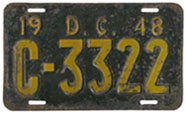 |
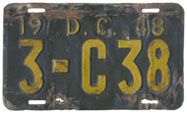 |
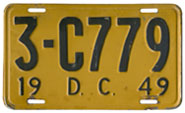 |
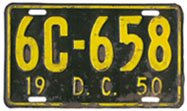 |
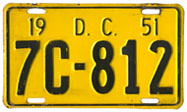 |
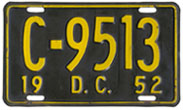 |
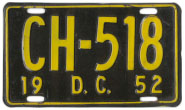 |
We are unaware of any documented information about the change made to the commercial registration numbering format for the 1952 registration year. However, the existence of plates marked C-2943, CD-466, CH-518, and CI-483 suggests that the 1948-51 system was abandoned in favor of plates numbered C-1 through C-9999 (as before), followed by the introduction of a serial letter, presumably beginning with A, then numbers 1 (or perhaps 100) through 999.
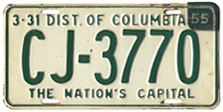 1953-1954. The numbering format of the two-year 1953 baseplate appears to be similar to the 1952 plate except that the number of digits following two-letter prefixes was increased from three to four. Numbers C-7761 and CJ-3770 are known. The second of these two registration combinations presents a problem, however, in that it suggests a quantity of truck registrations far in excess of what is expected. Assuming that the first numbers distributed were C-1 through C-9999 accounts for 9,999 registered vehicles. If we assume that numbering then began at CA-1000 and progressed to CA-9999, that's another 8,999 trucks. If this is indeed the way truck plates were numbered, and if we further assume that all letters from A through J were used in the second (serial letter) position (note that the letter I was indeed used on 1952 truck plates), the issuance of registration CJ-3770 suggests that there were at least 93,760 trucks registered during the two-year period that this base was distributed, which sees unreasonably high. There were not quite 200,000 autos, trucks, and buses registered in 1950.
1953-1954. The numbering format of the two-year 1953 baseplate appears to be similar to the 1952 plate except that the number of digits following two-letter prefixes was increased from three to four. Numbers C-7761 and CJ-3770 are known. The second of these two registration combinations presents a problem, however, in that it suggests a quantity of truck registrations far in excess of what is expected. Assuming that the first numbers distributed were C-1 through C-9999 accounts for 9,999 registered vehicles. If we assume that numbering then began at CA-1000 and progressed to CA-9999, that's another 8,999 trucks. If this is indeed the way truck plates were numbered, and if we further assume that all letters from A through J were used in the second (serial letter) position (note that the letter I was indeed used on 1952 truck plates), the issuance of registration CJ-3770 suggests that there were at least 93,760 trucks registered during the two-year period that this base was distributed, which sees unreasonably high. There were not quite 200,000 autos, trucks, and buses registered in 1950.
1955-1964. Truck plates were replaced annually from 1955 (marked 3-31-56) through 1964 (3-31-65), and things seem to have gotten a little more predictable and uniform during this period. With one exception, plates of this type shared color schemes and other characteristics with passenger car plates. The type name continued to be omitted, but C-prefix registration numbers remained.
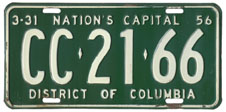 |
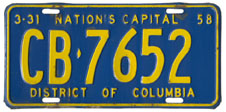 |
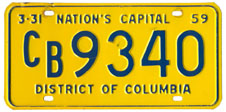 |
1955 |
1957 |
1958 |
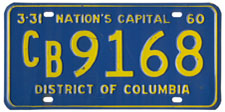 |
 |
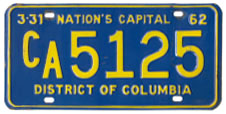 |
1959 |
1960 |
1961 |
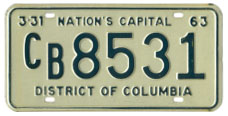 |
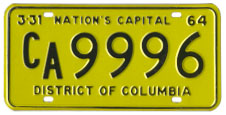 |
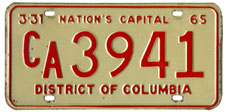 |
1962 |
1963 |
1964 |
Regarding 1955-64 numbering, the first series used in previous years, C-1 through C-9999, was abandoned, and numbering for each year began at CA-1000. However, at least one exception was made. According to a DMV memorandum dated January 17, 1957, which was 9.5 months into the life of the black-on-yellow 1956 plate (the only year missing from our collection pictured above), the supply of commercial plates was amended to include only plates numbered through CC-20-00, with higher-numbered CC-series plates, namely CC-20-01 through CC-99-99, being released for issuance to private auto owners.
|
Most interesting about this era, and perhaps all years of this type, is the 1957 design. As discussed on a separate page, the appearance and numbering of D.C. license plates was changed significantly for the 1957 registration year. New dies then introduced are wider than those used to make 1956 and earlier plates such that a six digit registration number, which was in the late 1950s a standard feature of commercial plates, could not be accommodated. Judging by the appearance of 1958 truck plates, which introduced the distinctive, diagonal CA and CB prefixes used through the 1964 registration year, officials were apparently determined to not change the truck numbering configuration but they also apparently couldn't devise a way to present six digits on 1957 plates using the new dies. Therefore, they (presumably quickly) devised a hybrid.
With the sole exception of its color scheme, every visual characteristic of 1957 truck plates is reminiscent of earlier auto and truck plates rather than 1957 plates made for other vehicle types. (Click here to see 1957 plates of a variety of types.) Plates of both types are steel, but as is evident in the size and placement of the bolt slots, not only were the older dies used to make 1957 truck plates but they even were made on older metal stock. Careful examination shows that all of the dies needed to make 1957 commercial plates, including those used to emboss the slogan, expiration date, and city name, are of the earlier style. By the time 1958 plates were manufactured, however, diagonal CA and CB prefix dies that occupy about the same space as a single character had been created, allowing truck plates to be made in the same style as plates of other types.
 |
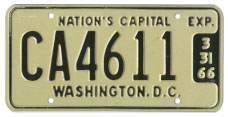 |
1964 and 1965 truck plates |
|
1965-1968. The 1965 commercial baseplate, used for four registration years from April 1965 through March 1969, introduced the slender dies that made their debut on passenger plates in the following year and became synonymous with D.C. plates used through the end of the century. An unusual feature of this base is the raised sticker area and corresponding vertical-format 1966 ("67"), 1967 ("68"), and 1968 ("69") stickers centered on the right border. Numbering is fairly consistent with prior plates although because this base was used for four years, not one, more numbers were required during its useful life, thus the introduction of the CC series. Plate CC-013 (pictured) proves that numbers in at least the C series started below 1000, unlike 1964 and earlier plates, but whether the CA and CB series also started below 1000 on this base is presently unknown.
There are three varieties of the 1965-68 base. The earliest and most plentiful has the original expiration date debossed in the sticker area, such as no. CA4611 pictured. The highest-numbered observed plate of this style is no. CB7681. The second variety is the same as the first except for the absence of the debossed 3-31-66 expiration date, and numbers CC-013 and CC4389 are the lowest and highest known examples, respectively.
 |
|
1965 base |
|
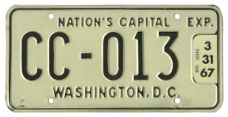 |
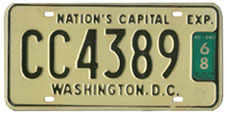 |
Undated variety of the 1965 base validated for 1966 |
Undated variety of the 1965 base with natural 1967 validation |
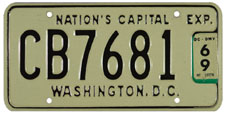 |
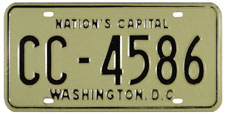 |
1968: Renewal registration showing the 1968 ("69") sticker |
1968: Natural registration showing the 1968 base variety |
For the 1968 registration year truck owners with existing registrations marked the renewal of their plates already in use with a black-on-white sticker dated "69." However, plates made for new registrations were slightly redesigned with the removal of the "EXP." notation from the upper right corner and the sticker platform that had been below it. With these features gone the registration number was spread across the plate. Although there is no visible evidence of the registration validity on these natural 1968 truck plates, this is consistent with new passenger car plates issued for the 1968 registration year so these truck plates blended in nicely. CC-4586 is the lowest known example of the natural 1968 baseplate.
Truck plates of all three 1965-68 varieties were replaced during March 1969 with new dated, annual plates, bringing to an end (at least temporarily) the short-lived era of multi-year D.C. truck plates.
1969-1973. Dated black-on-white plates were issued annually during the this five-year period. Numbers began at C-101 for 1969 through 1972 but numbering of 1973 plates began at a number higher than the expected highest 1972 registration, hence numbers (such as C-22576 pictured) that look unusually high for this type.
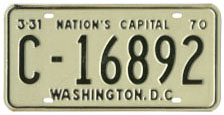 |
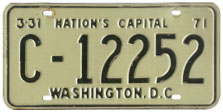 |
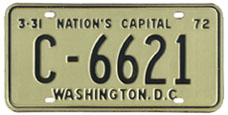 |
1969 |
1970 |
1971 |
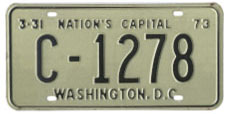 |
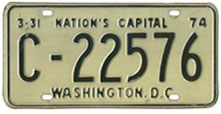 |
1972 |
1973 |
Commercial Multi-Year Baseplates Issued Since 1974
 |
1974 Baseplate It is assumed that this baseplate was issued for commercial vehicles during the same period that it was issued for private passenger vehicles, that being April 1974 through March 1978. C-101 was the first number assigned, and the highest number observed on this base is C-12484. |
|
1974/1978 baseplate cutoff point documentation gap: C-12485 to C-27449 (14,965 numbers) |
||
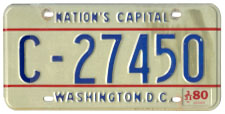 |
1978 Baseplate This base was likely issued only for new registrations from April 1978 to Sept. 1984, as was the case with 1978 base auto plates. Truck plates issued during part of the 1980 and 1981 registration years have a green back, as do auto plates of the same period. The lowest and highest numbers seen on this base are C-27450 and C-37071. | |
1978/1984 baseplate cutoff point documentation gap: C-37072 to C-42359 (5,288 numbers) |
||
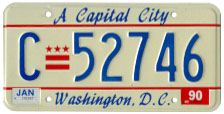 |
1984 Baseplate This base was likely introduced in Oct. 1984, when the design was introduced for passenger car plates, or possibly shortly thereafter. All 1974 and 1978 baseplates then in use were likely replaced by plates of this design. The lowest and highest numbers observed on the 1984 base are C-42360 and C-58104. |
|
1984/1993 baseplate cutoff point documentation gap: C-58105 to C-61132 (3,028 numbers) |
||
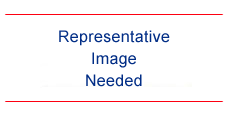 |
1993 Baseplate Although the Celebrate and Discover slogan debuted on auto plates in mid-1991, it was probably a few more years before all 1984 baseplates could be issued, at which time the change would have been reflected on truck plates. The lowest and highest numbers seen on plates with the slogan at the top are C-61133 and C-63944. |
|
1993/1997 baseplate cutoff point documentation gap: C-63945 to C-64071 (127 numbers) |
||
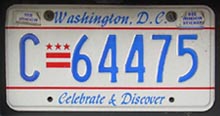 |
1997 Baseplate When the general-issue passenger registration number format was changed to AB-1234 in April 1997, the position of the city name and slogan were reversed. This change is thought to have been reflected in truck plates during 1997 or 1998. The lowest and highest observed numbers of this base are C-64072 and C-66464. | |
1997/2001 baseplate cutoff point documentation gap: C-66465 to C-66627 (163 numbers) |
||
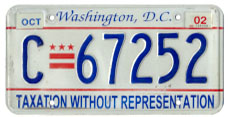 |
2001 Baseplate The first commercial plates with the "TAXATION" legend have an embossed registration number, so we assume they were issued during 2001, shortly after the passenger version of this base was introduced in Nov. 2000. The lowest and highest observed numbers in this relatively small batch of plates are C-66628 and C-67803. | |
2001/2002 baseplate cutoff point documentation gap: C-67804 to C-68571 (768 numbers) |
||
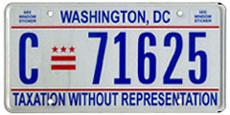 |
2002 Baseplate We believe that flat truck plates began to be issued in early 2002. It is almost certain that there are two variants. Because plate stickers were still being used when this base style was introduced, they presumably do not have SEE WINDOW STICKER printed in the upper corners. The lowest observed flat style commercial plate is C-68572. |
Estimate of Commercial Registration Numbers Assigned Annually
With the relatively small number of truck registrations issued and the distinct possibility that they are not issued at a steady rate, but rather sometimes in batches due to a fleet of commercial vehicles being registered, we have found it difficult to make estimates as to numbers assigned annually, even in recent years. Number C-70353 was the highest observed number in use as of Dec. 30, 2004, and C-75089 was the newest plate seen as of Dec. 12, 2011, meaning that approximately 4,746 numbers were assigned from 2005 through 2011. The average quantity of truck plates issued during this seven-year period is therefore 678. During the 38-year period from 1974 through 2011, 75,000 numbers were assigned, an average of 1,974 annually.
|
This page last updated on December 31, 2017 |
 |
|
copyright 2006-2018 Eastern Seaboard Press Information and images on this Web site may not be copied or reproduced in any manner without consent of the owner. For information, send an e-mail to admin@DCplates.net |

